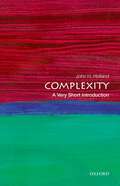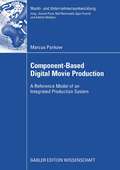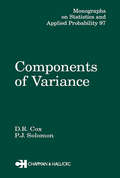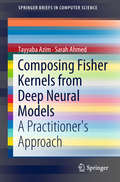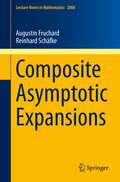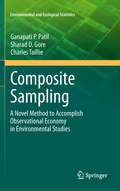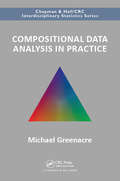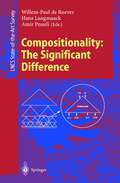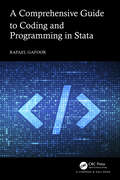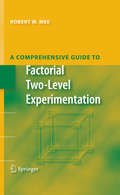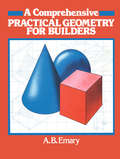- Table View
- List View
Complexity: A Very Short Introduction (Very Short Introductions)
by John H. HollandThe importance of complexity is well-captured by Hawking's comment: "Complexity is the science of the 21st century". From the movement of flocks of birds to the Internet, environmental sustainability, and market regulation, the study and understanding of complex non-linear systems has become highly influential over the last 30 years. In this Very Short Introduction, one of the leading figures in the field, John Holland, introduces the key elements and conceptual framework of complexity. From complex physical systems such as fluid flow and the difficulties of predicting weather, to complex adaptive systems such as the highly diverse and interdependent ecosystems of rainforests, he combines simple, well-known examples — Adam Smith's pin factory, Darwin's comet orchid, and Simon's 'watchmaker' — with an account of the approaches, involving agents and urn models, taken by complexity theory. ABOUT THE SERIES: The Very Short Introductions series from Oxford University Press contains hundreds of titles in almost every subject area. These pocket-sized books are the perfect way to get ahead in a new subject quickly. Our expert authors combine facts, analysis, perspective, new ideas, and enthusiasm to make interesting and challenging topics highly readable.
Component-based Digital Movie Production: Reference Model of an Integrated Production System (Markt- und Unternehmensentwicklung Markets and Organisations)
by Marcus PankowMarcus Pankow examines the specifics of the movie production industry and its value-creating processes, reflecting the digitization and its impact on the information systems strategy. Following the concept of a Service Oriented Architecture (SOA), he encapsulates established applications in services and integrates them on one platform.
Components of Variance (Chapman & Hall/CRC Monographs on Statistics and Applied Probability)
by D. R. CoxIdentifying the sources and measuring the impact of haphazard variations are important in any number of research applications, from clinical trials and genetics to industrial design and psychometric testing. Only in very simple situations can such variations be represented effectively by independent, identically distributed random variables or by r
Composing Fisher Kernels from Deep Neural Models: A Practitioner's Approach (SpringerBriefs in Computer Science)
by Tayyaba Azim Sarah AhmedThis book shows machine learning enthusiasts and practitioners how to get the best of both worlds by deriving Fisher kernels from deep learning models. In addition, the book shares insight on how to store and retrieve large-dimensional Fisher vectors using feature selection and compression techniques. Feature selection and feature compression are two of the most popular off-the-shelf methods for reducing data’s high-dimensional memory footprint and thus making it suitable for large-scale visual retrieval and classification. Kernel methods long remained the de facto standard for solving large-scale object classification tasks using low-level features, until the revival of deep models in 2006. Later, they made a comeback with improved Fisher vectors in 2010. However, their supremacy was always challenged by various versions of deep models, now considered to be the state of the art for solving various machine learning and computer vision tasks. Although the two research paradigms differ significantly, the excellent performance of Fisher kernels on the Image Net large-scale object classification dataset has caught the attention of numerous kernel practitioners, and many have drawn parallels between the two frameworks for improving the empirical performance on benchmark classification tasks. Exploring concrete examples on different data sets, the book compares the computational and statistical aspects of different dimensionality reduction approaches and identifies metrics to show which approach is superior to the other for Fisher vector encodings. It also provides references to some of the most useful resources that could provide practitioners and machine learning enthusiasts a quick start for learning and implementing a variety of deep learning models and kernel functions.
Composite Asymptotic Expansions (Lecture Notes in Mathematics #2066)
by Augustin Fruchard Reinhard SchafkeThe purpose of these lecture notes is to develop a theory of asymptotic expansions for functions involving two variables, while at the same time using functions involving one variable and functions of the quotient of these two variables. Such composite asymptotic expansions (CAsEs) are particularly well-suited to describing solutions of singularly perturbed ordinary differential equations near turning points. CAsEs imply inner and outer expansions near turning points. Thus our approach is closely related to the method of matched asymptotic expansions. CAsEs offer two unique advantages, however. First, they provide uniform expansions near a turning point and away from it. Second, a Gevrey version of CAsEs is available and detailed in the lecture notes. Three problems are presented in which CAsEs are useful. The first application concerns canard solutions near a multiple turning point. The second application concerns so-called non-smooth or angular canard solutions. Finally an Ackerberg-O’Malley resonance problem is solved.
Composite Media and Homogenization Theory: An International Centre for Theoretical Physics Workshop Trieste, Italy, January 1990 (Progress in Nonlinear Differential Equations and Their Applications #5)
by Gianfausto Dell'Antonio Gianni Dal MasoComposite Sampling: A Novel Method to Accomplish Observational Economy in Environmental Studies (Environmental and Ecological Statistics #4)
by Ganapati P. Patil Sharad D. Gore Charles TaillieSampling consists of selection, acquisition, and quantification of a part of the population. While selection and acquisition apply to physical sampling units of the population, quantification pertains only to the variable of interest, which is a particular characteristic of the sampling units. A sampling procedure is expected to provide a sample that is representative with respect to some specified criteria. Composite sampling, under idealized conditions, incurs no loss of information for estimating the population means. But an important limitation to the method has been the loss of information on individual sample values, such as, the extremely large value. In many of the situations where individual sample values are of interest or concern, composite sampling methods can be suitably modified to retrieve the information on individual sample values that may be lost due to compositing. This book presents statistical solutions to issues that arise in the context of applications of composite sampling.
Composition Methods in Homotopy Groups of Spheres. (AM-49), Volume 49 (PDF)
by Hiroshi TodaThe description for this book, Composition Methods in Homotopy Groups of Spheres. (AM-49), Volume 49, will be forthcoming.
Composition Operators: and Classical Function Theory (Universitext)
by Joel H. ShapiroThe study of composition operators links some of the most basic questions you can ask about linear operators with beautiful classical results from analytic-function theory. The process invests old theorems with new mean ings, and bestows upon functional analysis an intriguing class of concrete linear operators. Best of all, the subject can be appreciated by anyone with an interest in function theory or functional analysis, and a background roughly equivalent to the following twelve chapters of Rudin's textbook Real and Complex Analysis [Rdn '87]: Chapters 1-7 (measure and integra tion, LP spaces, basic Hilbert and Banach space theory), and 10-14 (basic function theory through the Riemann Mapping Theorem). In this book I introduce the reader to both the theory of composition operators, and the classical results that form its infrastructure. I develop the subject in a way that emphasizes its geometric content, staying as much as possible within the prerequisites set out in the twelve fundamental chapters of Rudin's book. Although much of the material on operators is quite recent, this book is not intended to be an exhaustive survey. It is, quite simply, an invitation to join in the fun. The story goes something like this.
Composition Operators on Spaces of Analytic Functions (Studies In Advanced Mathematics Ser.)
by Carl C. Cowen Jr.The study of composition operators lies at the interface of analytic function theory and operator theory. Composition Operators on Spaces of Analytic Functions synthesizes the achievements of the past 25 years and brings into focus the broad outlines of the developing theory. It provides a comprehensive introduction to the linear operators of composition with a fixed function acting on a space of analytic functions. This new book both highlights the unifying ideas behind the major theorems and contrasts the differences between results for related spaces. Nine chapters introduce the main analytic techniques needed, Carleson measure and other integral estimates, linear fractional models, and kernel function techniques, and demonstrate their application to problems of boundedness, compactness, spectra, normality, and so on, of composition operators. Intended as a graduate-level textbook, the prerequisites are minimal. Numerous exercises illustrate and extend the theory. For students and non-students alike, the exercises are an integral part of the book. By including the theory for both one and several variables, historical notes, and a comprehensive bibliography, the book leaves the reader well grounded for future research on composition operators and related areas in operator or function theory.
Composition Operators on Spaces of Analytic Functions (Studies In Advanced Mathematics Ser.)
by Carl C. Cowen Jr.The study of composition operators lies at the interface of analytic function theory and operator theory. Composition Operators on Spaces of Analytic Functions synthesizes the achievements of the past 25 years and brings into focus the broad outlines of the developing theory. It provides a comprehensive introduction to the linear operators of composition with a fixed function acting on a space of analytic functions. This new book both highlights the unifying ideas behind the major theorems and contrasts the differences between results for related spaces. Nine chapters introduce the main analytic techniques needed, Carleson measure and other integral estimates, linear fractional models, and kernel function techniques, and demonstrate their application to problems of boundedness, compactness, spectra, normality, and so on, of composition operators. Intended as a graduate-level textbook, the prerequisites are minimal. Numerous exercises illustrate and extend the theory. For students and non-students alike, the exercises are an integral part of the book. By including the theory for both one and several variables, historical notes, and a comprehensive bibliography, the book leaves the reader well grounded for future research on composition operators and related areas in operator or function theory.
Compositional Data Analysis: CoDaWork, L’Escala, Spain, June 2015 (Springer Proceedings in Mathematics & Statistics #187)
by Josep Antoni Martín-Fernández Santiago Thió-HenestrosaThe authoritative contributions gathered in this volume reflect the state of the art in compositional data analysis (CoDa). The respective chapters cover all aspects of CoDa, ranging from mathematical theory, statistical methods and techniques to its broad range of applications in geochemistry, the life sciences and other disciplines. The selected and peer-reviewed papers were originally presented at the 6th International Workshop on Compositional Data Analysis, CoDaWork 2015, held in L’Escala (Girona), Spain.Compositional data is defined as vectors of positive components and constant sum, and, more generally, all those vectors representing parts of a whole which only carry relative information. Examples of compositional data can be found in many different fields such as geology, chemistry, economics, medicine, ecology and sociology. As most of the classical statistical techniques are incoherent on compositions, in the 1980s John Aitchison proposed the log-ratio approach to CoDa. This became the foundation of modern CoDa, which is now based on a specific geometric structure for the simplex, an appropriate representation of the sample space of compositional data. The International Workshops on Compositional Data Analysis offer a vital discussion forum for researchers and practitioners concerned with the statistical treatment and modelling of compositional data or other constrained data sets and the interpretation of models and their applications. The goal of the workshops is to summarize and share recent developments, and to identify important lines of future research.
Compositional Data Analysis: Theory and Applications (Statistics In Practice Ser.)
by Vera Pawlowsky-Glahn Antonella BucciantiIt is difficult to imagine that the statistical analysis of compositional data has been a major issue of concern for more than 100 years. It is even more difficult to realize that so many statisticians and users of statistics are unaware of the particular problems affecting compositional data, as well as their solutions. The issue of ``spurious correlation'', as the situation was phrased by Karl Pearson back in 1897, affects all data that measures parts of some whole, such as percentages, proportions, ppm and ppb. Such measurements are present in all fields of science, ranging from geology, biology, environmental sciences, forensic sciences, medicine and hydrology. This book presents the history and development of compositional data analysis along with Aitchison's log-ratio approach. Compositional Data Analysis describes the state of the art both in theoretical fields as well as applications in the different fields of science. Key Features: Reflects the state-of-the-art in compositional data analysis. Gives an overview of the historical development of compositional data analysis, as well as basic concepts and procedures. Looks at advances in algebra and calculus on the simplex. Presents applications in different fields of science, including, genomics, ecology, biology, geochemistry, planetology, chemistry and economics. Explores connections to correspondence analysis and the Dirichlet distribution. Presents a summary of three available software packages for compositional data analysis. Supported by an accompanying website featuring R code. Applied scientists working on compositional data analysis in any field of science, both in academia and professionals will benefit from this book, along with graduate students in any field of science working with compositional data.
Compositional Data Analysis: Theory and Applications
by Vera Pawlowsky-Glahn Antonella BucciantiIt is difficult to imagine that the statistical analysis of compositional data has been a major issue of concern for more than 100 years. It is even more difficult to realize that so many statisticians and users of statistics are unaware of the particular problems affecting compositional data, as well as their solutions. The issue of ``spurious correlation'', as the situation was phrased by Karl Pearson back in 1897, affects all data that measures parts of some whole, such as percentages, proportions, ppm and ppb. Such measurements are present in all fields of science, ranging from geology, biology, environmental sciences, forensic sciences, medicine and hydrology. This book presents the history and development of compositional data analysis along with Aitchison's log-ratio approach. Compositional Data Analysis describes the state of the art both in theoretical fields as well as applications in the different fields of science. Key Features: Reflects the state-of-the-art in compositional data analysis. Gives an overview of the historical development of compositional data analysis, as well as basic concepts and procedures. Looks at advances in algebra and calculus on the simplex. Presents applications in different fields of science, including, genomics, ecology, biology, geochemistry, planetology, chemistry and economics. Explores connections to correspondence analysis and the Dirichlet distribution. Presents a summary of three available software packages for compositional data analysis. Supported by an accompanying website featuring R code. Applied scientists working on compositional data analysis in any field of science, both in academia and professionals will benefit from this book, along with graduate students in any field of science working with compositional data.
Compositional Data Analysis in Practice (Chapman & Hall/CRC Interdisciplinary Statistics)
by Michael GreenacreCompositional Data Analysis in Practice is a user-oriented practical guide to the analysis of data with the property of a constant sum, for example percentages adding up to 100%. Compositional data can give misleading results if regular statistical methods are applied, and are best analysed by first transforming them to logarithms of ratios. This book explains how this transformation affects the analysis, results and interpretation of this very special type of data. All aspects of compositional data analysis are considered: visualization, modelling, dimension-reduction, clustering and variable selection, with many examples in the fields of food science, archaeology, sociology and biochemistry, and a final chapter containing a complete case study using fatty acid compositions in ecology. The applicability of these methods extends to other fields such as linguistics, geochemistry, marketing, economics and finance. R Software The following repository contains data files and R scripts from the book https://github.com/michaelgreenacre/CODAinPractice . The R package easyCODA, which accompanies this book, is available on CRAN -- note that you should have version 0.25 or higher. The latest version of the package will always be available on R-Forge and can be installed from R with this instruction: install.packages("easyCODA", repos="http://R-Forge.R-project.org").
Compositional Data Analysis in Practice (Chapman & Hall/CRC Interdisciplinary Statistics)
by Michael GreenacreCompositional Data Analysis in Practice is a user-oriented practical guide to the analysis of data with the property of a constant sum, for example percentages adding up to 100%. Compositional data can give misleading results if regular statistical methods are applied, and are best analysed by first transforming them to logarithms of ratios. This book explains how this transformation affects the analysis, results and interpretation of this very special type of data. All aspects of compositional data analysis are considered: visualization, modelling, dimension-reduction, clustering and variable selection, with many examples in the fields of food science, archaeology, sociology and biochemistry, and a final chapter containing a complete case study using fatty acid compositions in ecology. The applicability of these methods extends to other fields such as linguistics, geochemistry, marketing, economics and finance. R Software The following repository contains data files and R scripts from the book https://github.com/michaelgreenacre/CODAinPractice . The R package easyCODA, which accompanies this book, is available on CRAN -- note that you should have version 0.25 or higher. The latest version of the package will always be available on R-Forge and can be installed from R with this instruction: install.packages("easyCODA", repos="http://R-Forge.R-project.org").
Compositionality: International Symposium, COMPOS’97 Bad Malente, Germany, September 8–12, 1997 Revised Lectures (Lecture Notes in Computer Science #1536)
by Willem-Paul De Roever Hans Langmaack Amir PnueliThis book originates from the International Symposium on Compositionality, COMPOS'97, held in Bad Malente, Germany in September 1997. The 25 chapters presented in revised full version reflect the current state of the art in the area of compositional reasoning about concurrency. The book is a valuable reference for researchers and professionals interested in formal systems design and analysis; it also is well suited for self study and use in advanced courses.
Compound Poisson Approximation
by V. Čekanavičius S. Y. NovakCompound Poisson approximation appears naturally in situations where one deals with a large number of rare events. It has important applications in insurance, extreme value theory, reliability theory, mathematical biology, and more. Compound Poisson Approximation synthesizes the most important recent research in the field in a single volume. With an extensive list of references, open problems, and exercises, it will become the standard reference book on the topic. Features• Provides a comprehensive overview of this rapidly expanding field • Synthesizes the most important research results of recent years • Presents an array of special topics• Provides the reader with a set of tools needed for research and education The book is of interest to researchers and postgraduate students from probability, statistics, and mathematics.
Compound Poisson Approximation
by V. Čekanavičius S. Y. NovakCompound Poisson approximation appears naturally in situations where one deals with a large number of rare events. It has important applications in insurance, extreme value theory, reliability theory, mathematical biology, and more. Compound Poisson Approximation synthesizes the most important recent research in the field in a single volume. With an extensive list of references, open problems, and exercises, it will become the standard reference book on the topic. Features• Provides a comprehensive overview of this rapidly expanding field • Synthesizes the most important research results of recent years • Presents an array of special topics• Provides the reader with a set of tools needed for research and education The book is of interest to researchers and postgraduate students from probability, statistics, and mathematics.
Comprehensive Applied Mathematical Modeling in the Natural and Engineering Sciences: Theoretical Predictions Compared with Data
by David J. Wollkind Bonni J. DichoneThis text demonstrates the process of comprehensive applied mathematical modeling through the introduction of various case studies. The case studies are arranged in increasing order of complexity based on the mathematical methods required to analyze the models. The development of these methods is also included, providing a self-contained presentation. To reinforce and supplement the material introduced, original problem sets are offered involving case studies closely related to the ones presented. With this style, the text’s perspective, scope, and completeness of the subject matter are considered unique. Having grown out of four self-contained courses taught by the authors, this text will be of use in a two-semester sequence for advanced undergraduate and beginning graduate students, requiring rudimentary knowledge of advanced calculus and differential equations, along with a basic understanding of some simple physical and biological scientific principles.
A Comprehensive Guide to Coding and Programming in Stata
by Rafael GafoorThis book is an introductory guide to programming and coding in Stata. Commonly encountered code in the field of medical statistics as well as the analyses of observational data are presented.For those who are involved in the analyses of observational studies, the need to sometimes assemble large datasets will necessitate a detailed understanding of loops and macros. This book covers these materials early on and then describes other commonly required coding commands.For those who program in a controlled environment (.e.g. medical statisticians who perform analyses for regulatory bodies), the production of log files, a suggested folder structure and analysis pathway are covered. This book also includes a wide range of tabulation commands and other methods of producing tables of descriptive statistics. The text also then provides a clear explanation of how to perform some inferential analyses (including how to extract and format the coefficients for use in subsequent reports).The focus on coding allows beginners to grasp the basics of coding and programming, as well as allowing established researchers to hone their skills and become more advanced programmers.Key Features: Covers the fundamental of using and understanding Stata. Able to be used by anyone looking to learn the basics of coding. Introduces and explains difficult concepts such as macros from the outset.
A Comprehensive Guide to Factorial Two-Level Experimentation
by Robert MeeThis book contains the most comprehensive coverage available anywhere for two-level factorial designs. The re-analysis of 50 published examples serves as a how-to guide for analysis of the many types of full factorial and fractional factorial designs. By focusing on two-level designs, this book is accessible to a wide audience of practitioners who use planned experiments.
Comprehensive Mathematics for Computer Scientists 1: Sets and Numbers, Graphs and Algebra, Logic and Machines, Linear Geometry (Universitext)
by Guerino Mazzola Gérard Milmeister Jody WeissmannContains all the mathematics that computer scientists need to know in one place.
Comprehensive Mathematics for Computer Scientists 2: Calculus and ODEs, Splines, Probability, Fourier and Wavelet Theory, Fractals and Neural Networks, Categories and Lambda Calculus (Universitext)
by Guerino Mazzola Gérard Milmeister Jody WeissmannThis second volume of a comprehensive tour through mathematical core subjects for computer scientists completes the ?rst volume in two - gards: Part III ?rst adds topology, di?erential, and integral calculus to the t- ics of sets, graphs, algebra, formal logic, machines, and linear geometry, of volume 1. With this spectrum of fundamentals in mathematical e- cation, young professionals should be able to successfully attack more involved subjects, which may be relevant to the computational sciences. In a second regard, the end of part III and part IV add a selection of more advanced topics. In view of the overwhelming variety of mathematical approaches in the computational sciences, any selection, even the most empirical, requires a methodological justi?cation. Our primary criterion has been the search for harmonization and optimization of thematic - versity and logical coherence. This is why we have, for instance, bundled such seemingly distant subjects as recursive constructions, ordinary d- ferential equations, and fractals under the unifying perspective of c- traction theory.
